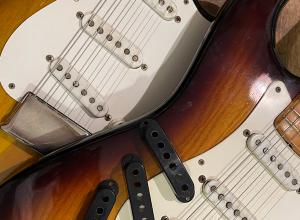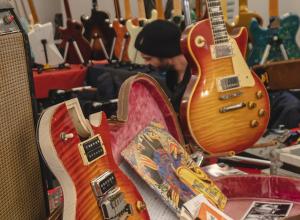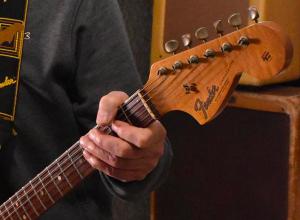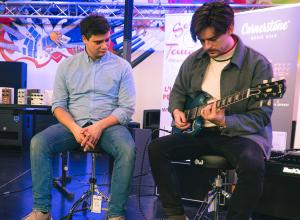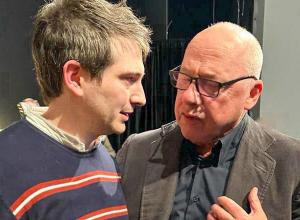L’immensità del loro inventario è messa a disposizione dei clienti in uno spazio molto elegante e confortevole, dove David e la sua socia/figlia Paige, così come tutto il loro staff, vi faranno provare alcuni incredibili pezzi della loro collezione. Attualmente, in tutto il mondo, non esiste un posto come Well Strung Guitars a Farmingdale, NY.
Abbiamo chiesto a David di rispondere ad alcune domande sulla sua storia, sulla sua passione e sulle sue aspettative future.
Domanda: Buongiorno David e grazie per essere qui con noi oggi! Cominciamo con la domanda (solo apparentemente) più facile… Che cosa significa “Vintage” per te?
Risposta: È una bella domanda. Per me si tratta probabilmente del “passare del tempo” per gli strumenti costruiti prima degli anni Settanta. Anche se non compro regolarmente chitarre costruite negli anni ’70, di tanto in tanto mi capita di scambiarle con dei clienti. Ma sicuramente porrei un limite, ad esempio per le Fender, al 1975.
D: Quando ha acquistato la sua prima chitarra “vintage”? Qual è stata?
R: Me lo ricordo molto bene, era il 1970 e lessi l’annuncio di una chitarra Gibson in una vendita di famiglia. Mio padre mi ci portò in macchina, ero un ragazzino di 12 anni. Si trattava di una bellissima Gibson ES-125 TC Cherry Sunburst, quindi un modello Thinline, con la sua custodia in ottime condizioni. All’epoca mi sembrava molto “rock and roll”. Purtroppo la signora che la vendeva chiedeva 100 dollari, che io non avevo, dato che avevo solo 40 dollari dalla vendita dei giornali! Mio padre riuscì a far scendere la signora ai 40 dollari che potevo permettermi e io tornai a casa felice con la mia prima chitarra “vintage”!
D: Quando hai capito che quelle “vecchie chitarre” avevano qualcosa di speciale?
R: Quando ho trovato il mio primo lavoro in un negozio di musica non era affatto come lo si immagina, visto che in pratica scaricavo i camion per un panino! (ride) Ma nel seminterrato c’era un’officina per le riparazioni e il vecchio signore che ci lavorava mi metteva in mano quelle vecchie chitarre. Un giorno mi diede una Stratocaster con manico a V del 56/57. Rispetto a quelle più recenti era incredibilmente migliore! Era il 1975, quindi eravamo abituati a chitarre pesanti e con finiture spesse, che non assomigliavano affatto alle loro controparti più vecchie. Quella Stratocaster 1956 era diversa, la sensazione, l’aspetto, il tono….I L’ho subito capita.
D: Quando hai aperto il tuo primo negozio “vintage”?
R: Sono in questo settore da molto tempo, avendo lavorato in diversi negozi di Manhattan. Uno di questi era Sam Ash, dove sono stato assunto per trovare e acquistare chitarre per ben nove anni. Vi sorprenderà sapere che in realtà ho aperto il mio primo negozio di chitarre solo nel 2004! Con me c’era il mio vecchio socio Ritchie Friedman ed è nato “We Buy Guitars”.
D: Una chitarra che hai venduto e che poi ti sei pentito di aver venduto?
R: TUTTE! Perché non importa se l’hai tenuta per 5 minuti o per molto tempo, ti penti sempre di averne venduta una buona. L’ultima che mi viene in mente è una bellissima Gibson ES-335 del 1959 che ho cercato di comprare dal proprietario originale più di 20 anni fa. All’epoca non voleva venderla, ma prese nota del mio nome e promise che un giorno mi avrebbe contattato. Con mia grande sorpresa ha mantenuto la promessa e mi ha trovato tutti questi anni dopo, anche se da allora ho spostato la sede del negozio almeno tre volte, e alla fine mi ha venduto la chitarra. Era fantastica e mi sono pentito di averla venduta!
D: La scoperta di chitarra più folle e inaspettata che hai fatto?
R: Si tratta sicuramente delle Telecaster del 1958, una destra e una mancina, delle sorelle Friedlich. Appartenevano a due sorelle, le Friedlich Sisters, che avevano un gruppo musicale chiamato Tweedle Dees. “Esther Friedlich era la gemella mancina e alla fine comprai da lei la Tele mancina. Sua sorella, Bertha, era una ragazza piuttosto massiccia. Alla fine degli anni ’50 andarono a visitare Fender, dove videro una Telecaster Sunburst a tre toni nuova di zecca che Fender stava offrendo e se ne innamorarono. Ma Bertha si lamentò che la chitarra era troppo pesante e le dava fastidio al seno. Lei si comportava da “prima donna” e George Fullerton si accorse della situazione: si presentò e disse che poteva risolvere il problema ordinando la chitarra con i contorni in stile Strat. le ragazze hanno ricevuto le chitarre qualche mese dopo. In pratica ordinarono un set di Telecaster del 1958 in Sunburst, che era già di per sé un ordine personalizzato (il colore standard delle Telecaster era “Blond”). Una era destra e una mancina, e quella destra fu modificata con un corpo sagomato in stile Stratocaster totalmente “custom”. Dopo molto tempo sono riuscito a riaccoppiarle, quando la figlia di Bertha mi ha regalato la chitarra sagomata per esporla al Museo Songbird.
D: Il marchio/modello Vintage più sottovalutato?
R: Probabilmente le Epiphone Rivieras e Sheraton, che per molti sono solo “versioni da poveri” di marchi/modelli storici, ma in realtà sono chitarre costruite in modo eccellente. La maggior parte delle volte erano costruite con gli stessi materiali, parti e hardware delle loro costose controparti di marca “Gibson”.
D: Qual è la chitarra più rara che hai trovato nella tua carriera?
R: È sicuramente la Fender Esquire “Lamp button” del 1949. L’ho avuta dalla famiglia dei proprietari originali, che ai tempi lavoravano alla Fender. Mi ci sono voluti ben sette anni per ottenerla, poiché i ragazzi erano estremamente timidi e non fornivano grandi informazioni sullo strumento. Ma alla fine la pazienza fu ripagata, quando un giorno mi recai da loro durante la fiera NAMM. Ricordo chiaramente cosa provai quando vidi quella rarissima custodia “tweed thermometer”. Capii subito che quella chitarra doveva essere qualcosa di speciale, ma non potevo immaginare che si trattasse proprio del prototipo fotografato da Leo Fender per il catalogo Fender del 1950!
D: Quali sono le 10 chitarre più importanti attualmente nella sua collezione, dal suo punto di vista personale?
R: Ecco la mia lista:
- La Fender Stratocaster del 1957 in Desert Sand con manico in palissandro massiccio in un unico pezzo e protezione in oro anodizzato, appartenuta a Eddie Cletro.
- La Fender Stratocaster “Jimi Hendrix” del 1968, interamente in palissandro, realizzata per lui prima di morire
- La Les Paul Custom del 1957 con l’esclusivo sistema di cablaggio in stile “Mickey Baker”.
- La Gibson Firebird VII del 1964, come nuova, con finitura Heather Poly e hardware dorato (ne sono state prodotte solo 20!).
- Una L.P. Junior degli anni ’50 a doppio taglio con finitura Sunburst, una chitarra straordinaria che suona come un paradiso!
- La collezione “Fullerton Red”: una Stratocaster del 1957, un Precision Bass del 1956 e una Telecaster del 1957.
- La Fender Telecaster del 1951 in Sunburst di fabbrica con Bigsby di fabbrica
- La Fender Broadcaster di John Entwistle
- Gibson Les Paul “Burst” “Petey” del 1959
- Gibson ES-335 del 1958 in Sunburst di Mel Bay, con un corpo unico più sottile e un ingresso jack laterale!
D: Qual è la tua chitarra “isola deserta” e perché?
R: La Fender Stratocaster di Eddie Cletro del 1957. È una delle pochissime chitarre “one off” realizzate da Leo Fender. Ha una bella storia di famiglia, suonata da un artista che Leo rispettava pienamente. Ha una sensazione unica grazie alla finitura a olio, al manico monopezzo in palissandro e ai 3 pickup celestialmente bilanciati.
D: L’esperienza del Museo Songbirds ti manca? Ha in programma di trasferire la collezione in un museo in futuro?
R: Il Museo Songbirds è stata una grande idea/concetto e non ho rimpianti! Naturalmente è stato triste quando abbiamo dovuto chiuderlo, ma non è mai stato un fallimento. Se lo rifacessi, cercherei sicuramente una sede adeguata a New York o a Nashville, e probabilmente mi avvarrei dell’aiuto di alcuni amici. Joe Bonamassa è tra questi e forse un giorno ci lavoreremo su.
D: Qual è la tua percezione sul futuro del vintage?
R: È positiva, vedo un numero crescente di giovani che preferiscono queste “chitarre vintage” all’instabile mercato azionario. Ma, a prescindere dall’importante aspetto economico, la cosa più importante è continuare a incoraggiare le giovani generazioni a GIOCARE la musica, qualsiasi strumento va bene! È la passione di suonare con gli altri che rende questi vecchi strumenti “speciali”.
Il prossimo 14 maggio 2023 alla fiera Vintage Vault di Milano sarà esposta una ricca selezione di chitarre provenienti dall’incredibile Dream Shop di Well Strung Guitars.
Puoi seguire David su e sul di Well Strung Guitars.
[EN] Vintage Visions from the world: David Davidson from Well Strung Guitars - USA
David Davidson is the co-owner and co-founder of Davidson’s Well Strung Guitars. It would be extremely reductive to call it just a “guitar shop”, but rather an immersive experience in the true beauty of Vintage Guitars. The immensity of their inventory is made available for customers in a very elegant and comfortable space, where David and his business partner/daughter Paige, as well as all of their staff, will let you try some incredible pieces from their collection. Currently, worldwide, there is no place like Well Strung Guitars in Farmingdale, NY. We’ve asked David to answer to a few questions regarding his story, passion and future expectations.
Question: Good morning David and thanks for being here today with us! So let’s start with the (only apparently) easiest question… What does “Vintage” mean for you?
Answer: That’s a good question. To me it is probably about the “passage of time” for instruments that were made before the 1970s. Although I do not buy guitars made in the 70s on a regular basis, I do happen to trade them with customers from time to time. But definitely I would set a limit, for Fenders for example, to 1975.
Q: When did you buy your very first “vintage” guitar? Which one was it?
A: I recall that very well, it was 1970 and I read a “Gibson Guitar” listing in a local family estate sale. My father drove a young, 12 years old me there. It was a beautiful, Cherry Sunburst Gibson ES-125 TC, so a Thinline model, with its hardshell case in beautiful condition. It looked very “rock and roll” to me at the time. Unfortunately, the lady selling it was asking $100, which I didn’t have since I only had $40 from selling newspapers! My father was able to bring the lady down to the $40 I could afford, and I went home happy with my first “vintage” guitar!
Q: When did you realize that those “old guitars” had something special?
A: When I got my first job in a music store it was nothing like you’d imagine, in fact I was basically unloading the trucks for a sandwich!! (laughs) But there was a repair shop in the basement and the old gentleman who did the repairs used to put those old guitars in my hands. One day he gave me this 56/57 “V” neck Stratocaster. Compared to the newer ones it was just unbelievably better! It was 1975 so we were used to heavy, thickly finished guitars that didn’t look anything like their older counterparts. That 56 Stratocaster was different, the feel, the look, the tone….I Immediately got it.
Q: When did you opened your first “vintage” shop?
A: I’ve been in this business for quite a long time now, having worked in several shops in Manhattan. Sam Ash was one of them, where I was hired to find and buy guitars for a good 9 years. You’d be surprised to know that I actually only opened my first guitar store in 2004! My old partner Ritchie Friedman was there with me and “We Buy Guitars” was born.
Q: A guitar you sold and then regretted selling?
A: ALL OF THEM! Because it doesn’t really matter if you kept it for 5 minutes or a long time, you always regret selling a good one. The last one that comes to mind though is a beautiful 1959 Gibson ES-335 that I tried to buy from the original owner over 20 years ago. He didn’t want to sell it at that time, but noted my name and promised he would reach out one day. To my surprise he kept his promise and found me all these years later, even though I moved the store location at least three times since, and finally sold me the guitar. It was fantastic and I do regret selling it!
Q: The craziest/most unexpected guitar find you’ve ever had?
A: It’s for sure the Friedlich Sister’s matching 1958 lefty and righty Telecasters!! They belonged to two sisters – the Friedlich Sisters – and they had a musical singing group called the Tweedle Dees. “Esther Friedlich was the left-handed twin and, eventually, I bought the left-handed Tele from her. Meanwhile, her sister, Bertha, was a heavyset girl. They went to visit Fender back in the late ’50s, where they saw a brand-new three-tone Sunburst Telecaster Fender was offering and fell in love. But, Bertha complained that the guitar was too heavy and cut into her bosom, and George Fullerton was alerted to the situation because she was acting a little ‘prima donna’. So, he went in and said that he could solve it and had the guitar ordered for her [with Strat-style contours built in]. They received the guitars a few months later.” So they basically ordered a matching set of 1958 Telecasters in Sunburst, which was already a custom order (Standard Telecaster color was “Blond”). One was right handed and one was left handed, and the right handed one received a totally “custom” “Strat” style contoured body. After a long time I was able to pair them back together when Bertha’s daughter gave the contoured guitar to me to be displayed at Songbird’s Museum.
Q: The most underrated Vintage brand/model?
A: It’s probably the Epiphone Rivieras and Sheratons that to most are just “poor man’s versions” of historic brands/models, but actually they’re excellently built guitars. Most of the time they had the same materials, parts, and hardware as their expensive “Gibson” branded counterparts.
Q: What is the rarest guitar you’ve found in your career?
A: It is for sure the 1949 “Lamp button” Fender Esquire!! I got it from the family of the original owners, who worked at Fender back in the day. It took me a good seven years to get it, since the guys were extremely shy and didn’t provide great information about the instrument. But ultimately patience paid off, when one day I travelled to their place while attending the NAMM show. I clearly recall what I felt when I saw that insanely rare “tweed thermometer” case. I immediately knew that the guitar had to be something special, but couldn’t have imagined it was the very prototype that Leo Fender photographed himself for the 1950 Fender Catalog!!
Q: What are the 10 most important guitars currently in your Collection, from your personal perspective?
A: Here’s my list:
- The 1957 Fender Stratocaster in Desert Sand with a solid, one-piece rosewood neck and anodized gold guard, owned by Eddie Cletro
- The “Jimi Hendrix” all rosewood 1968 Fender Stratocaster, made for him before he died
- The 1957 Les Paul Custom with unique “Mickey Baker” style wiring system
- The “like new” 1964 Gibson Firebird VII in Heather Poly finish with gold hardware (they made only 20 of them!)
- A 50s Double cut L.P. Junior in factory Sunburst, which is a stunning guitar that sounds like heaven!
- The “Fullerton Red” Collection: a 1957 Stratocaster, 1956 Precision Bass, and 1957 Telecaster
- The 1951 Fender Telecaster in factory Sunburst with a factory Bigsby
- The John Entwistle Fender Broadcaster
- 1959 Gibson Les Paul “Burst” “Petey”
- 1958 Gibson ES-335 in Sunburst owned by Mel Bay, which has a unique thinner body and a side input jack!
Q: What is your “desert island” guitar, and why?
A: The 1957 Eddie Cletro Fender Stratocaster. It is one of the very few, true “one off” guitars ever made by Leo Fender. It has a beautiful family history of ownership, played by an Artist that Leo respected fully. It has a unique feel from the oil finished, all rosewood one-piece neck, and 3 heavenly balanced pickups.
Q: The Songbirds Museum Experience, do you miss it? Any Plans to relocate the Collection in a Museum in the future?
A: The Songbirds Museum was a great idea/concept, and I’ve no regrets! Of course it was sad when we had to close it, but it was never a failure. If I did it again, I would definitely search for a proper location in either NYC or Nashville, and will probably use the help of a few friends. Joe Bonamassa is among them and maybe we will work on it someday in the future!
Q: What is your perception about the future of “Vintage Guitars”?
A: It is positive, I see a growing number of young people favoring these “Vintage guitars” rather than the unstable stock market. But, regardless of the important economic side of it, the most important thing is to keep encouraging younger generations to PLAY music, any instrument will be good! It is the passion for playing music with others that ultimately makes these old instruments “special”.
Well Strung Guitars will be represented next May 14, 2023 at our Vintage Vault show in Milan, even if you will not be there in person we will have a very nice selection of guitars that came from your incredible Dream Shop.
Be sure to follow David on and through the . |
 VINTAGE VAULT
VINTAGE VAULT
 SHG MUSIC SHOW
SHG MUSIC SHOW
 PEOPLE
PEOPLE
 STORE
STORE
 - Privacy - Accordo.it Srl - P.IVA 04265970964
- Privacy - Accordo.it Srl - P.IVA 04265970964
![Vintage Visions from the world: David Davidson di Well Strung Guitars - USA [IT-EN] Vintage Visions from the world: David Davidson di Well Strung Guitars - USA [IT-EN]](https://www.accordo.it/cloud-assets/730x450/redazionea5/images/deco/105362_strung-g.jpg)





















